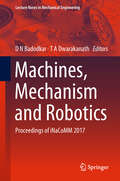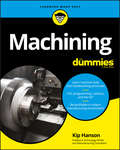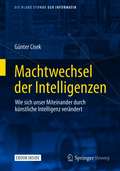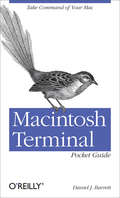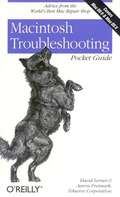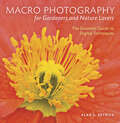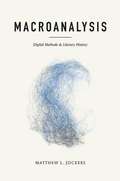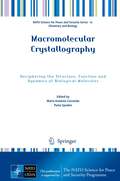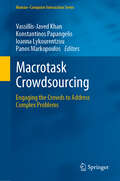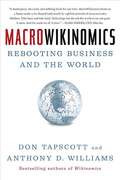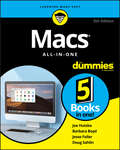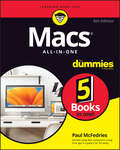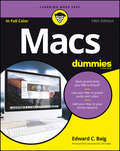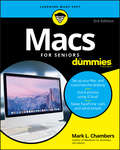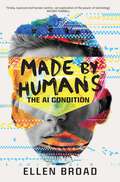- Table View
- List View
Machines, Mechanism and Robotics: Proceedings of iNaCoMM 2017 (Lecture Notes in Mechanical Engineering)
by D N Badodkar T A DwarakanathThis book offers a collection of original peer-reviewed contributions presented at the 3rd International and 18th National Conference on Machines and Mechanisms (iNaCoMM), organized by Division of Remote Handling & Robotics, Bhabha Atomic Research Centre, Mumbai, India, from December 13th to 15th, 2017 (iNaCoMM 2017). It reports on various theoretical and practical features of machines, mechanisms and robotics; the contributions include carefully selected, novel ideas on and approaches to design, analysis, prototype development, assessment and surveys. Applications in machine and mechanism engineering, serial and parallel manipulators, power reactor engineering, autonomous vehicles, engineering in medicine, image-based data analytics, compliant mechanisms, and safety mechanisms are covered. Further papers provide in-depth analyses of data preparation, isolation and brain segmentation for focused visualization and robot-based neurosurgery, new approaches to parallel mechanism-based Master-Slave manipulators, solutions to forward kinematic problems, and surveys and optimizations based on historical and contemporary compliant mechanism-based design. The spectrum of contributions on theory and practice reveals central trends and newer branches of research in connection with these topics.
Machining Center Programming Setup and Operation
by Mike LynchA textbook that takes its readers through understanding of what it takes to program, setup, and run a CNC machining center. Fourth Edition.
Machining For Dummies
by Kip HansonStart a successful career in machining Metalworking is an exciting field that's currently experiencing a shortage of qualified machinists—and there's no time like the present to capitalize on the recent surge in manufacturing and production opportunities. Covering everything from lathe operation to actual CNC programming, Machining For Dummies provides you with everything it takes to make a career for yourself as a skilled machinist. Written by an expert offering real-world advice based on experience in the industry, this hands-on guide begins with basic topics like tools, work holding, and ancillary equipment, then goes into drilling, milling, turning, and other necessary metalworking processes. You'll also learn about robotics and new developments in machining technology that are driving the future of manufacturing and the machining market. Be profitable in today's competitive manufacturing environment Set up and operate a variety of computer-controlled and mechanically controlled machines Produce precision metal parts, instruments, and tools Become a part of an industry that's experiencing steady growth Manufacturing is the backbone of America, and this no-nonsense guide will provide you with valuable information to help you get a foot in the door as a machinist.
Machining Simulation Using Solidworks Cam 2023
by Kuang-Hua ChangThis book will teach you all the important concepts and steps used to conduct machining simulations using SOLIDWORKS CAM. SOLIDWORKS CAM is a parametric, feature-based machining simulation software offered as an add-in to SOLIDWORKS. It integrates design and manufacturing in one application, connecting design and manufacturing teams through a common software tool that facilitates product design using 3D solid models. By carrying out machining simulation, the machining process can be defined and verified early in the product design stage. Some, if not all, of the less desirable design features of part manufacturing can be detected and addressed while the product design is still being finalized. In addition, machining-related problems can be detected and eliminated before mounting a stock on a CNC machine, and manufacturing cost can be estimated using the machining time estimated in the machining simulation. This book is intentionally kept simple. It’s written to help you become familiar with the practical applications of conducting machining simulations in SOLIDWORKS CAM. This book provides you with the basic concepts and steps needed to use the software, as well as a discussion of the G-codes generated. After completing this book, you should have a clear understanding of how to use SOLIDWORKS CAM for machining simulations and should be able to apply this knowledge to carry out machining assignments on your own product designs.
Machtwechsel der Intelligenzen: Wie sich unser Miteinander durch künstliche Intelligenz verändert (Die blaue Stunde der Informatik)
by Günter CisekDas Buch führt dem am gesellschaftlichen Leben interessierten Leser allgemein verständlich vor Augen, wie KI funktioniert und wie sie alle Lebensräume dramatisch verändern wird. Von der Geschichte der KI über ihre Techniken und ihre vielfältigen Anwendungsfelder bis zu ihren ethisch-philosophischen Implikationen werden alle relevanten Aspekte ausführlich dargestellt. Der Autor bleibt dabei nicht im Deskriptiven, sondern nimmt auch mit klaren Worten kritisch Stellung zur KI-Entwicklung. Für den Leser sind die Ausführungen als fachliches Stützkorsett angelegt, um gegenüber den KI-Experten als kundiger Counterpart auftreten zu können. Die letzten beiden Kapitel entführen den Leser in die Zukunft des Lebens mit der Super-KI. Mit gewagten Szenarien alarmiert der Autor den Leser auf vergnügliche Weise, welch atemberaubende und gesellschaftlich hochexplosive Perspektiven sich mit der KI verbinden und welche ethischen und philosophischen Fragestellungen sich daraus ergeben.
Macintosh Terminal Pocket Guide: Take Command of Your Mac
by Daniel J. BarrettUnlock the secrets of the Terminal and discover how this powerful tool solves problems the Finder can't handle. With this handy guide, you'll learn commands for a variety of tasks, such as killing programs that refuse to quit, renaming a large batch of files in seconds, or running jobs in the background while you do other work.Get started with an easy-to-understand overview of the Terminal and its partner, the shell. Then dive into commands neatly arranged into two dozen categories, including directory operations, file comparisons, and network connections. Each command includes a concise description of its purpose and features.Log into your Mac from remote locationsSearch and modify files in powerful waysSchedule jobs for particular days and timesLet several people use one Mac at the same timeCompress and uncompress files in a variety of formatsView and manipulate Mac OS X processesCombine multiple commands to perform complex operationsDownload and install additional commands from the Internet
Macintosh Troubleshooting Pocket Guide
by David Lerner Aaron Freimark Tekserve CorporationTekserve Corporation, the distinctive (and somewhat eccentric but excellent) Macintosh repair store in New York City, has long provided its customers with a free "Frequently Asked Questions" document to cover the most common troubleshooting questions. We recently discovered this FAQ sheet and realized that-like New York itself-it was too good to leave just for the New Yorkers. With the help of Tekserve's owners, we turned this FAQ sheet into the Macintosh Troubleshooting Pocket Guide. This handy little book covers the most common user hardware and software troubles, from disks stuck in drives to lost files-there are software tips going back as far as OS 6! Tekserve updates their FAQ sheet based on the frequency of questions from real users who come into the store every week. This guide is easy to take and use anywhere.
Macintosh Troubleshooting Pocket Guide
by David LernerThe Macintosh Troubleshooting Pocket Guide covers the most common user hardware and software trouble. It's not just a book for Mac OS X (although it includes tips for OS X and Jaguar), it's for anyone who owns a Mac of any type-- there are software tips going back as far as OS 6. This slim guide distills the answers to the urgent questions that Tekserve's employee's answer every week into a handy guide that fits in your back pocket or alongside your keyboard.
Macintosh Troubleshooting Pocket Guide for Mac OS: Advice from the World's Best Mac Repair Shop
by David Lerner Aaron Freimark Tekserve CorporationThe press has called Tekserve Corporation, the idiosyncratic Macintosh repair store in New York City, "The Epicenter of Mac Culture in NYC", "The leader in Apple triage services" and "warm and eclectic - maybe even a little eccentric".Unfortunately, not everyone can get down to Tekserve's West 23rd St location for the clear, down-to-earth Mac troubleshooting advice that Tekserve's owners dispense. For the rest of us, O'Reilly & Associates has published the Macintosh Troubleshooting Pocket Guide ($12.95) written by David Lerner and Aaron Freimark, of "the world's best Macintosh repair shop".This slim pocket guide has the answers to frequently asked Macintosh troubleshooting questions. Imagine the quirky record store in the movie "High Fidelity," or the popular "Car Talk" show on National Public Radio, and you'll have a good idea of this book's flavor.Tekserver has long provided its customers with a free "Frequently Asked Questions" document. We recently discovered this FAQ sheet and realized that-- like New York itself-- it was too good to leave just for the New Yorkers. With the help of Tekserve, we turned this FAQ sheet into the Macintosh Troubleshooting Pocket Guide.The Macintosh Troubleshooting Pocket Guide covers the most common user hardware and software trouble, from disks stuck in drives to lost files. It's not just a book for Mac OS X (although it includes tips for OS X and Jaguar, the latest release), it's for anyone who owns a Mac of any type-- there are software tips going back as far as OS 6. The Macintosh Troubleshooting Pocket Guide distills the answers to the urgent questions that Tekserve's employee's answer every week into a handy guide that fits in your back pocket or alongside your keyboard.
Macro Photography for Gardeners and Nature Lovers: The Essential Guide to Digital Techniques
by Alan L. DetrickGardeners and nature lovers delight in taking pictures—especially close-ups of flowers, butterflies, and insects. And though advances in digital camera technology have made taking, storing, and sharing photos easier than ever, taking top-quality pictures requires familiarity with both digital technology and the general principles of photography. Macro Photography for Gardeners and Nature Lovers provides exactly the information that aspiring photographers—no matter their level of skill—need to take their photos to the next level. Clear and concise chapters cover the basics of macro (close-up) photography, explain the features of current digital single-lens reflex cameras, show the many ways images can be composed, and share tips on digital effects, storage, and manipulation of imagery. Throughout the text, helpful tips, definitions, exercises, and case studies serve to demystify digital photography. Each lesson is supported by examples of the author's stunning photography. Whether taking photos of flowers and insects, compiling a photographic record of your garden, or simply sharing beautiful images with friends and family, everyone can become accomplished photographers of the world's small-scale wonders.
Macroanalysis: Digital Methods and Literary History
by Matthew L. JockersIn this volume, Matthew L. Jockers introduces readers to large-scale literary computing and the revolutionary potential of macroanalysis--a new approach to the study of the literary record designed for probing the digital-textual world as it exists today, in digital form and in large quantities. Using computational analysis to retrieve key words, phrases, and linguistic patterns across thousands of texts in digital libraries, researchers can draw conclusions based on quantifiable evidence regarding how literary trends are employed over time, across periods, within regions, or within demographic groups, as well as how cultural, historical, and societal linkages may bind individual authors, texts, and genres into an aggregate literary culture. Moving beyond the limitations of literary interpretation based on the "close-reading" of individual works, Jockers describes how this new method of studying large collections of digital material can help us to better understand and contextualize the individual works within those collections.
Macroeconomic Forecasting in the Era of Big Data: Theory and Practice (Advanced Studies in Theoretical and Applied Econometrics #52)
by Peter FulekyThis book surveys big data tools used in macroeconomic forecasting and addresses related econometric issues, including how to capture dynamic relationships among variables; how to select parsimonious models; how to deal with model uncertainty, instability, non-stationarity, and mixed frequency data; and how to evaluate forecasts, among others. Each chapter is self-contained with references, and provides solid background information, while also reviewing the latest advances in the field. Accordingly, the book offers a valuable resource for researchers, professional forecasters, and students of quantitative economics.
Macromolecular Crystallography
by Maria Armenia Carrondo Paola SpadonThis volume is a collection of the contributions presented at the 42nd Erice Crystallographic Course whose main objective was to train the younger generation on advanced methods and techniques for examining structural and dynamic aspects of biological macromolecules. The papers review the techniques used to study protein assemblies and their dynamics, including X-ray diffraction and scattering, electron cryo-electron microscopy, electro nanospray mass spectrometry, NMR, protein docking and molecular dynamics. A key theme throughout the book is the dependence of modern structural science on multiple experimental and computational techniques, and it is the development of these techniques and their integration that will take us forward in the future.
Macrotask Crowdsourcing: Engaging the Crowds to Address Complex Problems (Human–Computer Interaction Series)
by Panos Markopoulos Vassillis-Javed Khan Konstantinos Papangelis Ioanna LykourentzouCrowdsourcing is an emerging paradigm that promises to transform several domains: creative work, business work, cultural cooperation, etc. Crowdsourcing reflects the close-knit interplay between the latest computer technologies, the rapidly changing work model of the 21st century, and the very nature of people. The interplay makes for an exciting but at the same time challenging new field to investigate under the lens of a diverse set of disciplines, ranging from the technical to the social and from the theoretical to the applied. Early research has focused on an aspect of crowdsourcing known as micro-tasking. Micro-tasks are simple tasks (like image annotations) that anyone could perform. An emerging area is how to utilize crowdsourcing to solve problems that go beyond simple tasks towards more complex ones, that require collaboration and creativity. In juxtaposition to micro-task crowdsourcing, this book investigates macro-task crowdsourcing and its potential.
Macrowikinomics: Rebooting Business and the World
by Don Tapscott Anthony D. WilliamsIn their 2007 bestseller, Wikinomics Don Tapscott and Anthony Williams showed the world how mass collaboration was changing the way businesses communicate, create value, and compete in the new global marketplace. Now, in the wake of the global financial crisis, the principles of wikinomics have become more powerful than ever. Many of the institutions that have served us well for decades or centuries seem stuck in the past and unable to move forward. And yet, in every corner of the globe, a powerful new model of economic and social innovation is sweeping across all sectors--one where people with drive, passion, and expertise take advantage of new Web-based tools to get more involved in making the world more prosperous, just, and sustainable.
Macs All-In-One For Dummies
by Jesse Feiler Joe Hutsko Doug Sahlin Barbara BoydYour all-in-one guide to the wonderful world of your Mac Are you getting the most from your Mac? Given what’s possible, it’s pretty unlikely. Whether you’re just beginning your journey or are already a seasoned traveler, the six information-packed minibooks included in Macs All-in-One for Dummies open up a world of knowledge, from how to set up a recently bought Mac to exploring the coolest new features on your beloved device. Now updated with what you need to know about the newest generation of hardware and software, Macs All-in-One For Dummies is your guide to simply everything: protecting your Mac; backing up and restoring data with Time Machine; managing applications on the Dock, Launchpad, and Desktop; syncing with iCloud, organizing your life with Calendar, Reminders, Notes, and Notifications; presenting with Keynote; crunching with Numbers; getting creative with iMovie and GarageBand—the list goes on! Explore the newest version of MacOS Set up and customize a new Mac with ease Become more efficient, professional, smart, and creative with the latest must-have apps Use Home Sharing to stream content to other computers, iOS devices, and Apple TVs Dive into six books in one place: Mac Basics, Online Communications, Beyond the Basics, Your Mac as a Multimedia Entertainment Center, Taking Care of Business, and Mac Networking Whatever you want from your world of Mac, you’ll find it here—as well as a million other incredible things you’ll love. Get started on your new Mac journey today!
Macs All-in-One Desk Reference For Dummies
by Wallace WangWelcome to the wonderful world of the Mac! Whether you've just decided to switch from Windows or you've been using a Mac for awhile and want to take advantage of all its bells and whistles, Macs All-in-One Desk Reference For Dummies is the perfect guidebook to Mac land.You probably already know that Macs were made for media. There's iPhoto for organizing, editing, and sharing your digital photos; iMovie to let you become a moviemaker; iDVD for preserving that movie and playing your favorites; and of course, iTunes for managing your music. But your Mac is just as happy creating documents, browsing the Internet, putting together cool presentations, or even crunching numbers. This guide shows you how to use all those applications and more. Seven minibooks cover Mac basics; working with photos, movies, and music; using the Internet; working with iLife and iWork applications; various other Mac programs; time-saving tips; and networking. You'll discover how toSet up and customize a new MacGet online, choose a browser, configure an e-mail account, and instant-message with iChatHandle Mac security and troubleshoot problemsCreate a Web site with iWeb and get it onlineBack up your files, sync your stuff, and manage your life with your MacNetwork your Mac with other computers, even PCs, and share files, printers, and moreEven if you're a seasoned Mac veteran, we bet you'll find some things here you didn't know! And you'll refer to this book again and again.
Macs All-in-One For Dummies
by Joe Hutsko Barbara BoydThe ultimate beginner resource for learning the key features and tools of your MacMacs are easy to use, but this guide helps you take advantage of all the cool features and make the most of your Mac. Fully updated, it covers the newest operating system, as well as the latest versions of iLife and iWork. The featured minibooks introduce you to Mac basics; photos, music, and movies; the Internet; other Mac programs; timesaving tips with a Mac; and Mac networking. Serves as an ideal resource for those switching to a Mac from a PC as well as for Mac users who are upgradingHelps you set up and customize your Mac and get to know the Mac wayExplains how to get online, surf with Safari, and send and receive e-mailCovers working with photos, music, and movies, as well as crunching numbers and creating presentations with iWorkExplores setting up a network, running Windows on a Mac via Bootcamp, and automating your MacProvides troubleshooting tips and advice on protecting your MacMacs All-in-One For Dummies, 3nd Edition gives you the full scoop on using all the cool Mac features.
Macs All-in-One For Dummies
by Paul McFedriesThe huge reference guide you need to use the full power of your Mac Macs All-in-One For Dummies truly covers it all. This complete reference guide contains five books in one, so you can learn all your Mac is capable of. You’ll get a complete understanding of your computer, so you can use it for pleasure or business, become a multimedia master, surf the web like a pro, troubleshoot problems as they arise, and so much besides. This latest edition is updated for the newest version of macOS, the hottest apps, and the just-released Macs. Running an older Mac? Don’t worry, this book won’t leave you behind. Everything you need to do on your Mac can be learned with the help of Macs All-in-One For Dummies. Learn your way around your Mac and customize all the macOS features Discover the newest features (and the returning classics) so you can make the most of your machine Beef up your security, stay safe while surfing the web, and figure it out when things go wrong Use your computer to work, play, create videos, keep in touch, and everything else Computer users who are switching to a Mac for the first time, as well as previous Mac users who are upgrading to the newest model, need a guide for getting the most out of their powerful computer. This is that guide.
Macs For Dummies
by Edward C. BaigWhether you're thinking of switching to a Macintosh computer, are looking into the latest Apple products, or have a Mac and want to learn about Mac OS X Leopard, then Macs For Dummies, 10th Edition will get you going. Here you'll learn all about how to compare the different desktop and laptop models to choose your perfect match, make Mac OS X Leopard work your way, use the new iLife 2008 digital lifestyle applications, get online and connect to a wired or wireless network, and run Windows on your Mac so you can keep the Microsoft programs you need. You'll also discover how to:Navigate your way around the Mac interface and work with icons and foldersBest utilize OS X, work with the new Photo Booth, and manage clutter with Exposé and SpacesGet connected, start a Web-browsing Safari, use e-mail and iChat, and shop onlineJoin .Mac and take advantage of iDisk backups, IMAP mail, and Web GalleryExplore all that iTunes offers, process digital photos with iPhoto, make iMovies, and have fun with GarageBandUse Windows on your Mac and transfer Windows filesIt's a perfect time to join the Mac generation, especially if you're a Windows user who's been thinking of defecting. Macs For Dummies, 10th Edition will get you there, helping you pick peripherals, download freebie programs, set up user accounts, implement security secrets, troubleshoot your Mac, and experience the iLife.
Macs For Seniors For Dummies
by Mark L. ChambersRight now is always the right time to become a Mac expert! It’s never too late to become an expert on Macs—and this friendly, updated guide written specifically for the 50+ set is the easy way to do it! Featuring larger text and figures, Macs for Seniors for Dummies takes you through all you need to know to get the most out of your Apple computer. It makes it simple for you to stay in touch with family and friends, enjoy your favorite music, TV, and movies, and hang with the younger generation using the latest social apps and video games. Beginning with which Mac to choose for your needs, you’ll learn about setting up your computer, understanding files and folders, getting the most from the latest operating system, navigating the desktop, and troubleshooting common problems. And once you’ve found your feet there, it’ll be time to get creative with home movies and photography, chat face-to-face live on video, communicate through email—the sky’s the limit! Set up and customize your Mac Make FaceTime calls and send emails Store photos and files using iCloud Play video, movies, podcasts, and games Macs are for all ages! Show the Millennials in your life a thing or two and become a pro with yours today!
Macs For Seniors For Dummies
by Mark L. ChambersIt's never too late to become a Mac expert! Every year, hundreds of thousands of seniors choose to use Mac products—like the MacBook Air and iMac—to connect with their loved ones, access the web, and make their lives easier. And even if you've never used a Mac before, we're here to show you how you can make the most of it—one easy step at a time! The newly updated fifth edition of Macs For Seniors For Dummies is filled with large, easy-to-read text, sharp figures and illustrations, and accessible instructions to help you give the Gen-Z or millennial in your life a run for their money. You'll learn how to customize your Mac so it works exactly the way you want it to, connect to the Internet, work with documents and spreadsheets, play music, watch video, and even read the latest news headlines. This book walks you through how to secure your Mac so your privacy and data is protected and gets you comfortable with the operating system so you won't have to worry about “breaking” something again. You'll also find: Instructions for handy applications so you can make to-do lists and text documents Step-by-step instructions to keep your Mac updated for security and convenience Strategies to help you choose a Mac to buy (if you haven't bought one already) Macs are truly the computers for everyone! Whether you're looking to get started with Macs for the first time or you're a long-time Mac user searching for updates, Macs For Seniors For Dummies is where you'll find the easy-to-follow info you need. Grab a copy today!
Macs for Seniors For Dummies
by Mark L. ChambersOver 50 and thinking about getting your first computer? A user-friendly Mac is a great choice, and Macs For Seniors For Dummies walks you through choosing one and learning to use it. You won't even need your grandchildren to help! Macs For Seniors For Dummies introduces you to all the basic things you may not have encountered before-how to use the keyboard and mouse, work with files and folders, navigate around the Mac OS X desktop, set up an Internet connection, and much more. You'll learn to: Choose the Mac that's right for you, set it up, run programs and manage files, and hook up a printer Use all the programs that come with your Mac for creating documents and spreadsheets, playing movies and music, and more Surf the Internet with the Safari browser - safely Keep in touch with family and friends via e-mail Upload photos from your digital camera, edit and organize them with iPhoto, and share them by e-mail or as prints Play music with iTunes, put your favorite songs on a CD, or listen to online radio stations Use the Web to help plan trips, get maps, book hotels or RV campgrounds, or buy plane tickets Customize your Mac to make everything as easy and convenient as possible Even if you've never used a computer before, Macs For Seniors For Dummies makes it really easy to make friends with your Mac. Before you know it, you'll wonder why you waited so long to get a computer!
Mad Eyed Misfits: Writings on Indie Animation
by Chris RobinsonOne of the most stylistically original and provocative writers in animation returns with this informal sequel to his previous books on indie animation, Unsung Heroes of Animation and Animators Unearthed. In this collection, award-winning writer Chris Robinson looks at a wide range of films and filmmakers, including cult favourites Don Hertzfeldt, Adam Elliot, Masaaki Yuasa, Wong Ping, Bruce Bickford, Jodie Mack, Rosto, Suzan Pitt, Clyde Henry and Cartoon Saloon. Eclectic, opinionated, passionate and personal, Robinson’s writing will amuse, confuse, infuriate and enlighten while introducing readers to some of the most astonishing and important animation artists from around the world.
Made by Humans: The AI Condition
by Ellen BroadWho is designing AI? A select, narrow group. How is their world view shaping our future? Artificial intelligence can be all too human: quick to judge, capable of error, vulnerable to bias. It's made by humans, after all. Humans make decisions about the laws and standards, the tools, the ethics in this new world. Who benefits. Who gets hurt. Made by Humans explores our role and responsibilities in automation. Roaming from Australia to the UK and the US, elite data expert Ellen Broad talks to world leaders in AI about what we need to do next. It is a personal, thought-provoking examination of humans as data and humans as the designers of systems that are meant to help us.
